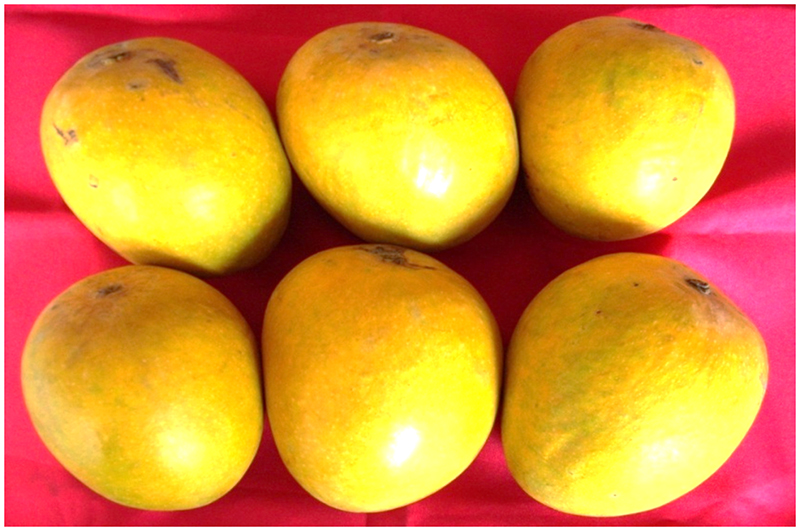 |
 |
Spongy Tissue
A causative factor for the development of spongy tissue, a major
physiological disorder in Alphonso mango has been
found and an ecofriendly formulation developed for
its prevention
|
|
|
|
|
Healthy |
|
Spongy |
 |
|
 |
|
|
Mango Spongy Tissue
: The cause of spongy tissue formation in
Alphonso mango was identified for the first time in the
world. Physiological and biochemical studies have firmly
established that the disorder is caused due to the
premature onset of germination-associated events in the
seed during fruit maturation on the tree/ postharvest
ripening stages. Radiotracer studies using tritiated
water confirmed the increased mobilization of water from
mesocarp to seed during spongy tissue formation.
Pre harvest application of GA3 to fruits during fruit
development phase resulted in an increase of seed
amylase activity, fruit respiratory rate and a
proportionate increase of the incidence of spongy tissue
while paclobutrazol application reduced the seed amylase
activity, fruit respiration and spongy tissue incidence
further confirming the fact that the formation of spongy
tissue in Alphonso mango is influenced by the activity
of seed.
Research
studies on Spongy tissue
Studies conducted on stone
weevil affected fruits of Alphonso mango clearly
established the decisive role played by the seed in the
formation of spongy tissue.
An eco-friendly formulation is developed and tested in
farmers’ fields in the Konkan region for the successful
control of the disorder.
|
'Arka
Saka Nivaraka’ - an environmentally-safe technology for
prevention of spongy tissue in Alphonso mango |
|
 Spongy
tissue disorder of Alphonso mango has been plaguing both
domestic and export marketing. Indian Institute of
Horticultural Research, Bengaluru, for the first time in
the world, developed an environmentally-safe formulation
‘Arka Saka Nivarak’ for prevention of spongy tissue.
"Arka Saka Nivaraka’ liquid formulation needs to be
applied twice at pre-harvest stage between 40 to 60 per
cent maturity, either by dipping the fruits (while on
the tree) in solution or by spray on the fruits, @ 100
to 125ml/ litre. Dipping ensures 100 per cent prevention
of spongy tissue, while, spray results in 95 to 98 per
cent success as a few fruits may escape contact with the
formulation. Dipping uses up lesser quantity of the
formulation and is economical, while, spray consumes
more volume of the formulation and is, thereby, slightly
more expensive. Pre-harvest dip treatment of fruits
twice between 40-60 per cent maturity stage @100 -
125ml/litre costs around 0.50 paisa/fruit, including
labour charges. Fruit-dippers of various capacities have
also been developed by IIHR for ease of dipping fruits
while on the tree, and these dippers reach a height of
upto 20' to 25' . Spongy
tissue disorder of Alphonso mango has been plaguing both
domestic and export marketing. Indian Institute of
Horticultural Research, Bengaluru, for the first time in
the world, developed an environmentally-safe formulation
‘Arka Saka Nivarak’ for prevention of spongy tissue.
"Arka Saka Nivaraka’ liquid formulation needs to be
applied twice at pre-harvest stage between 40 to 60 per
cent maturity, either by dipping the fruits (while on
the tree) in solution or by spray on the fruits, @ 100
to 125ml/ litre. Dipping ensures 100 per cent prevention
of spongy tissue, while, spray results in 95 to 98 per
cent success as a few fruits may escape contact with the
formulation. Dipping uses up lesser quantity of the
formulation and is economical, while, spray consumes
more volume of the formulation and is, thereby, slightly
more expensive. Pre-harvest dip treatment of fruits
twice between 40-60 per cent maturity stage @100 -
125ml/litre costs around 0.50 paisa/fruit, including
labour charges. Fruit-dippers of various capacities have
also been developed by IIHR for ease of dipping fruits
while on the tree, and these dippers reach a height of
upto 20' to 25' .
|
|
Fruits treated with Arka Saka Nivaraka two weeks
after harvest
|
 |
 |
|
|
|
|
The formulation also helps to improve fruit quality like
higher fruit weight (10-20%), better appearance, uniform
development of colour both externally and internally,
better fruit firmness, improved pulp texture, aroma and
extended shelf-life of fruits (up to 3 weeks under
ambient conditions).
Alphonso mango growers are recommended to use ‘Arka Saka
Nivaraka’ to obtain high quality fruits for export as
well as for domestic market at an affordable cost, and
earn extra income by obtaining higher quantity of
marketable fruits. The technology is available for
commercialization.
|
|
 |
|
| |
 |
|